FIT5166 Information Retrieval Systems: Vector Space Model Project
VerifiedAdded on 2023/06/04
|5
|1713
|397
Project
AI Summary
This document presents a solution to an information retrieval system project, focusing on the development of a search engine capable of indexing documents and retrieving relevant matches based on keyword queries using the vector space model. The project outlines the objectives, scope, and implementation plan, including the functionalities of various Java source files such as MySearchEngine.java, Searcher.java, Indexer.java, InvertedIndex.java, and Stemmer.java. It details the processes of tokenization, stemming, indexing, and search, along with risk mitigation strategies and assumptions. The expected outcome involves a program that compiles successfully, indexes documents, and returns a ranked list of relevant documents based on cosine similarity. The project concludes that the program effectively computes all source files and returns the expected results, confirming the successful development of the information retrieval system. Desklib provides access to similar past papers and solved assignments.
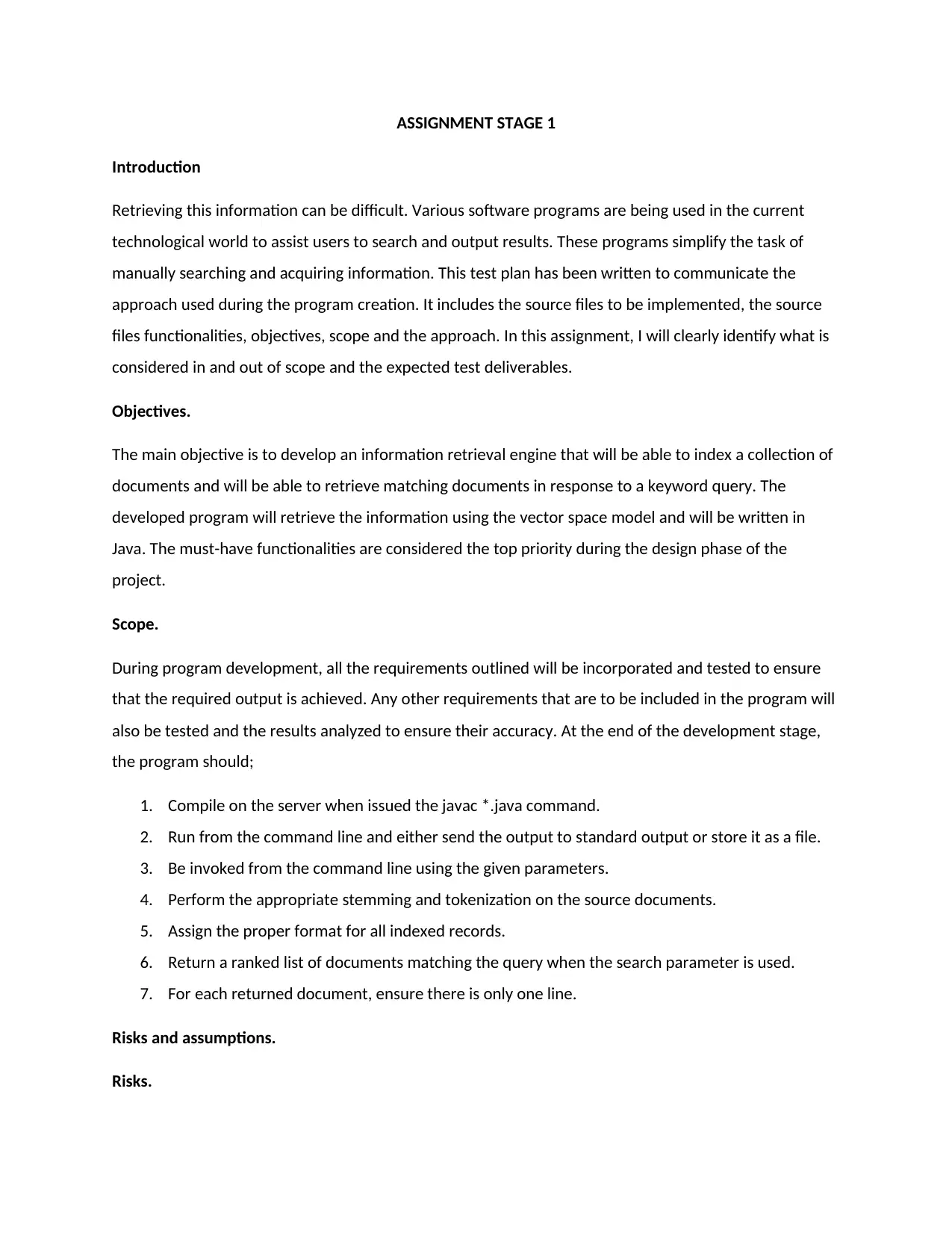
ASSIGNMENT STAGE 1
Introduction
Retrieving this information can be difficult. Various software programs are being used in the current
technological world to assist users to search and output results. These programs simplify the task of
manually searching and acquiring information. This test plan has been written to communicate the
approach used during the program creation. It includes the source files to be implemented, the source
files functionalities, objectives, scope and the approach. In this assignment, I will clearly identify what is
considered in and out of scope and the expected test deliverables.
Objectives.
The main objective is to develop an information retrieval engine that will be able to index a collection of
documents and will be able to retrieve matching documents in response to a keyword query. The
developed program will retrieve the information using the vector space model and will be written in
Java. The must-have functionalities are considered the top priority during the design phase of the
project.
Scope.
During program development, all the requirements outlined will be incorporated and tested to ensure
that the required output is achieved. Any other requirements that are to be included in the program will
also be tested and the results analyzed to ensure their accuracy. At the end of the development stage,
the program should;
1. Compile on the server when issued the javac *.java command.
2. Run from the command line and either send the output to standard output or store it as a file.
3. Be invoked from the command line using the given parameters.
4. Perform the appropriate stemming and tokenization on the source documents.
5. Assign the proper format for all indexed records.
6. Return a ranked list of documents matching the query when the search parameter is used.
7. For each returned document, ensure there is only one line.
Risks and assumptions.
Risks.
Introduction
Retrieving this information can be difficult. Various software programs are being used in the current
technological world to assist users to search and output results. These programs simplify the task of
manually searching and acquiring information. This test plan has been written to communicate the
approach used during the program creation. It includes the source files to be implemented, the source
files functionalities, objectives, scope and the approach. In this assignment, I will clearly identify what is
considered in and out of scope and the expected test deliverables.
Objectives.
The main objective is to develop an information retrieval engine that will be able to index a collection of
documents and will be able to retrieve matching documents in response to a keyword query. The
developed program will retrieve the information using the vector space model and will be written in
Java. The must-have functionalities are considered the top priority during the design phase of the
project.
Scope.
During program development, all the requirements outlined will be incorporated and tested to ensure
that the required output is achieved. Any other requirements that are to be included in the program will
also be tested and the results analyzed to ensure their accuracy. At the end of the development stage,
the program should;
1. Compile on the server when issued the javac *.java command.
2. Run from the command line and either send the output to standard output or store it as a file.
3. Be invoked from the command line using the given parameters.
4. Perform the appropriate stemming and tokenization on the source documents.
5. Assign the proper format for all indexed records.
6. Return a ranked list of documents matching the query when the search parameter is used.
7. For each returned document, ensure there is only one line.
Risks and assumptions.
Risks.
Paraphrase This Document
Need a fresh take? Get an instant paraphrase of this document with our AI Paraphraser
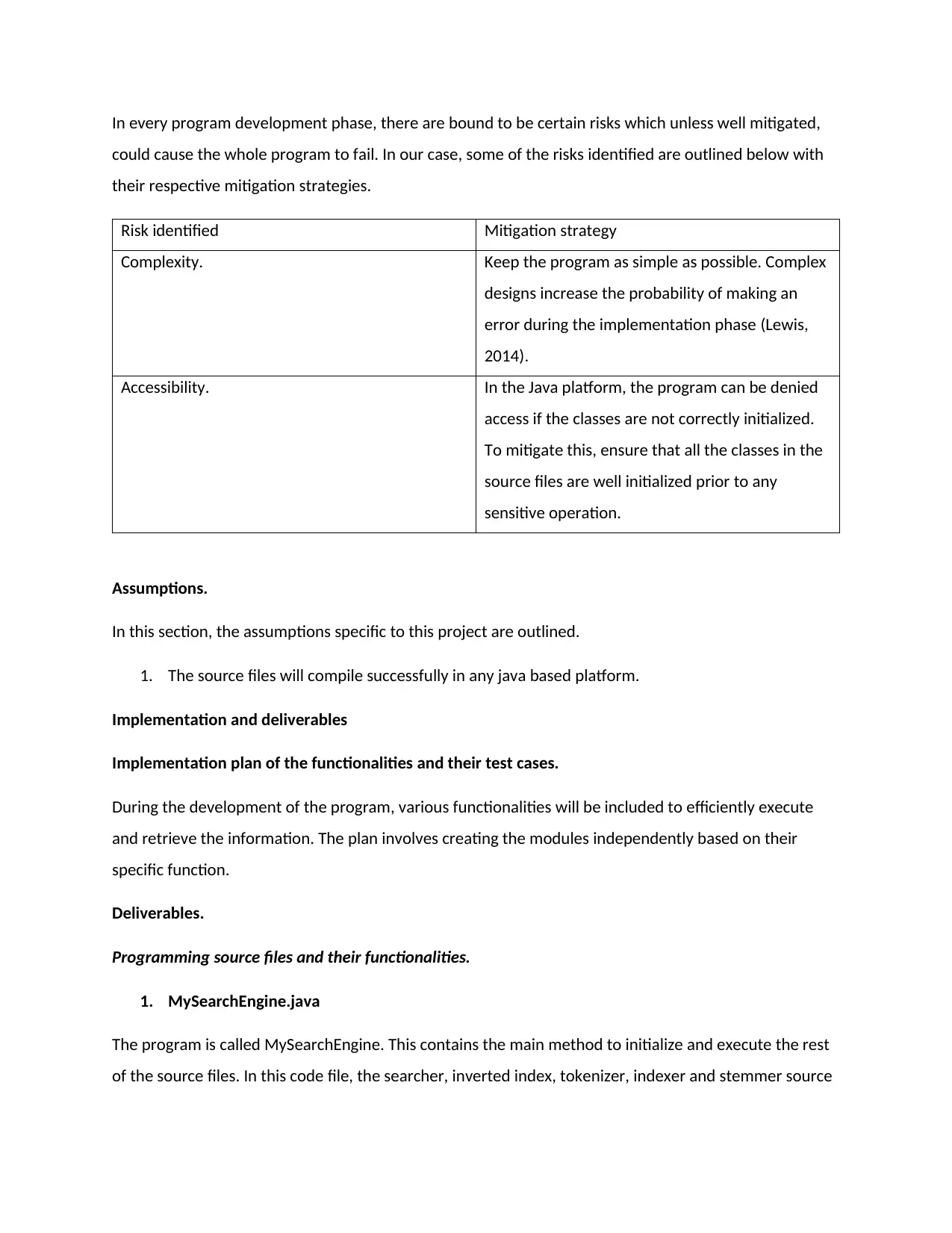
In every program development phase, there are bound to be certain risks which unless well mitigated,
could cause the whole program to fail. In our case, some of the risks identified are outlined below with
their respective mitigation strategies.
Risk identified Mitigation strategy
Complexity. Keep the program as simple as possible. Complex
designs increase the probability of making an
error during the implementation phase (Lewis,
2014).
Accessibility. In the Java platform, the program can be denied
access if the classes are not correctly initialized.
To mitigate this, ensure that all the classes in the
source files are well initialized prior to any
sensitive operation.
Assumptions.
In this section, the assumptions specific to this project are outlined.
1. The source files will compile successfully in any java based platform.
Implementation and deliverables
Implementation plan of the functionalities and their test cases.
During the development of the program, various functionalities will be included to efficiently execute
and retrieve the information. The plan involves creating the modules independently based on their
specific function.
Deliverables.
Programming source files and their functionalities.
1. MySearchEngine.java
The program is called MySearchEngine. This contains the main method to initialize and execute the rest
of the source files. In this code file, the searcher, inverted index, tokenizer, indexer and stemmer source
could cause the whole program to fail. In our case, some of the risks identified are outlined below with
their respective mitigation strategies.
Risk identified Mitigation strategy
Complexity. Keep the program as simple as possible. Complex
designs increase the probability of making an
error during the implementation phase (Lewis,
2014).
Accessibility. In the Java platform, the program can be denied
access if the classes are not correctly initialized.
To mitigate this, ensure that all the classes in the
source files are well initialized prior to any
sensitive operation.
Assumptions.
In this section, the assumptions specific to this project are outlined.
1. The source files will compile successfully in any java based platform.
Implementation and deliverables
Implementation plan of the functionalities and their test cases.
During the development of the program, various functionalities will be included to efficiently execute
and retrieve the information. The plan involves creating the modules independently based on their
specific function.
Deliverables.
Programming source files and their functionalities.
1. MySearchEngine.java
The program is called MySearchEngine. This contains the main method to initialize and execute the rest
of the source files. In this code file, the searcher, inverted index, tokenizer, indexer and stemmer source
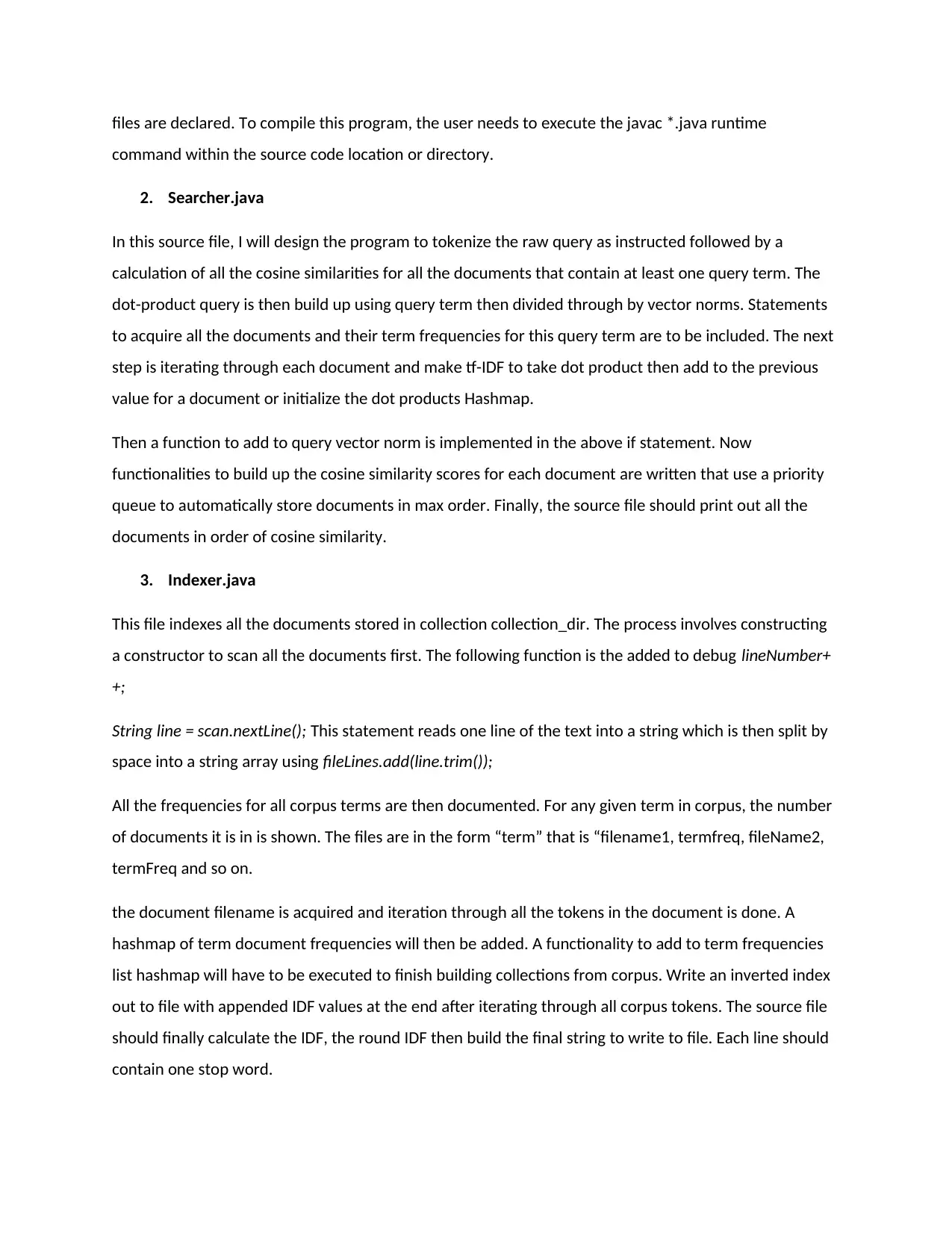
files are declared. To compile this program, the user needs to execute the javac *.java runtime
command within the source code location or directory.
2. Searcher.java
In this source file, I will design the program to tokenize the raw query as instructed followed by a
calculation of all the cosine similarities for all the documents that contain at least one query term. The
dot-product query is then build up using query term then divided through by vector norms. Statements
to acquire all the documents and their term frequencies for this query term are to be included. The next
step is iterating through each document and make tf-IDF to take dot product then add to the previous
value for a document or initialize the dot products Hashmap.
Then a function to add to query vector norm is implemented in the above if statement. Now
functionalities to build up the cosine similarity scores for each document are written that use a priority
queue to automatically store documents in max order. Finally, the source file should print out all the
documents in order of cosine similarity.
3. Indexer.java
This file indexes all the documents stored in collection collection_dir. The process involves constructing
a constructor to scan all the documents first. The following function is the added to debug lineNumber+
+;
String line = scan.nextLine(); This statement reads one line of the text into a string which is then split by
space into a string array using fileLines.add(line.trim());
All the frequencies for all corpus terms are then documented. For any given term in corpus, the number
of documents it is in is shown. The files are in the form “term” that is “filename1, termfreq, fileName2,
termFreq and so on.
the document filename is acquired and iteration through all the tokens in the document is done. A
hashmap of term document frequencies will then be added. A functionality to add to term frequencies
list hashmap will have to be executed to finish building collections from corpus. Write an inverted index
out to file with appended IDF values at the end after iterating through all corpus tokens. The source file
should finally calculate the IDF, the round IDF then build the final string to write to file. Each line should
contain one stop word.
command within the source code location or directory.
2. Searcher.java
In this source file, I will design the program to tokenize the raw query as instructed followed by a
calculation of all the cosine similarities for all the documents that contain at least one query term. The
dot-product query is then build up using query term then divided through by vector norms. Statements
to acquire all the documents and their term frequencies for this query term are to be included. The next
step is iterating through each document and make tf-IDF to take dot product then add to the previous
value for a document or initialize the dot products Hashmap.
Then a function to add to query vector norm is implemented in the above if statement. Now
functionalities to build up the cosine similarity scores for each document are written that use a priority
queue to automatically store documents in max order. Finally, the source file should print out all the
documents in order of cosine similarity.
3. Indexer.java
This file indexes all the documents stored in collection collection_dir. The process involves constructing
a constructor to scan all the documents first. The following function is the added to debug lineNumber+
+;
String line = scan.nextLine(); This statement reads one line of the text into a string which is then split by
space into a string array using fileLines.add(line.trim());
All the frequencies for all corpus terms are then documented. For any given term in corpus, the number
of documents it is in is shown. The files are in the form “term” that is “filename1, termfreq, fileName2,
termFreq and so on.
the document filename is acquired and iteration through all the tokens in the document is done. A
hashmap of term document frequencies will then be added. A functionality to add to term frequencies
list hashmap will have to be executed to finish building collections from corpus. Write an inverted index
out to file with appended IDF values at the end after iterating through all corpus tokens. The source file
should finally calculate the IDF, the round IDF then build the final string to write to file. Each line should
contain one stop word.
⊘ This is a preview!⊘
Do you want full access?
Subscribe today to unlock all pages.

Trusted by 1+ million students worldwide
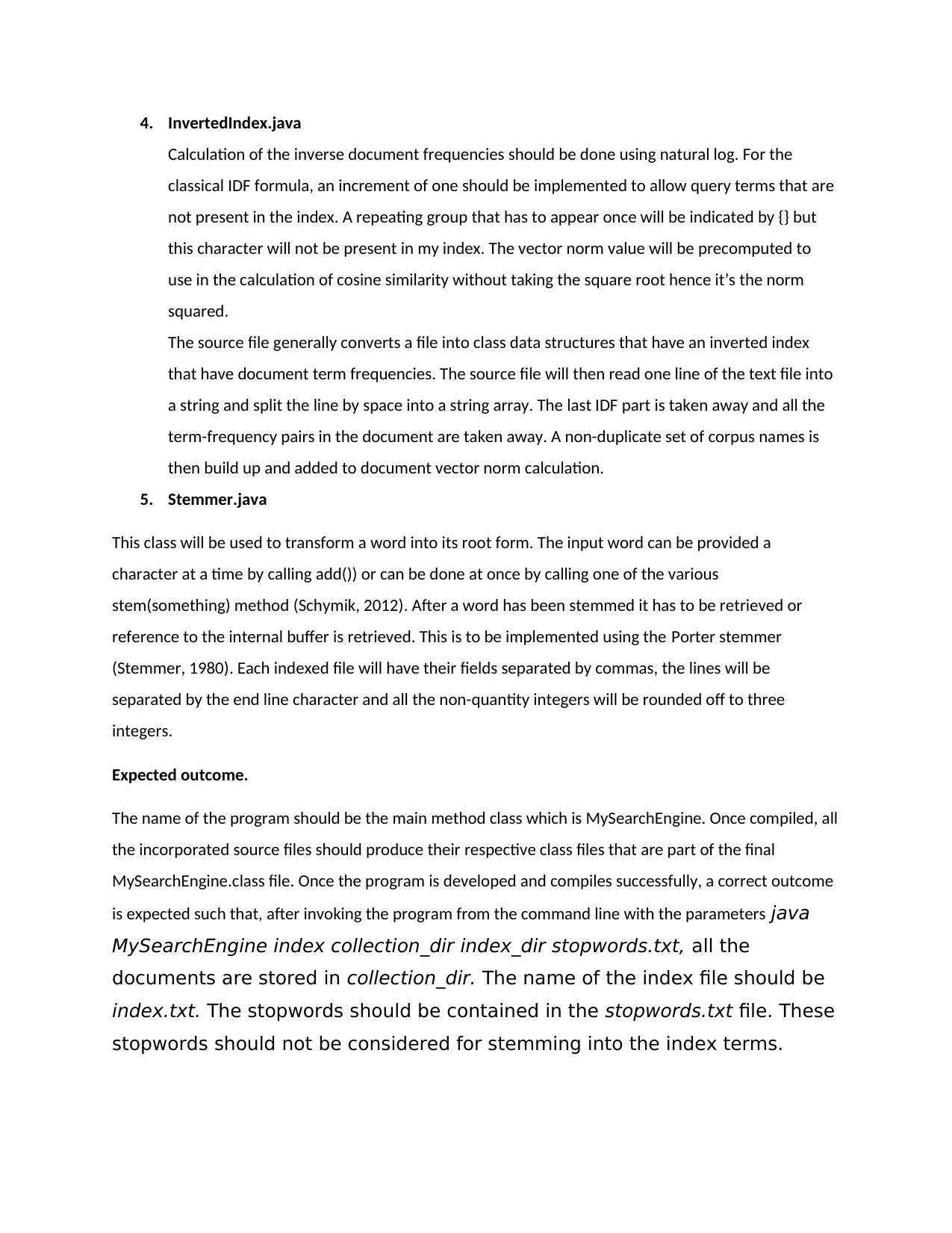
4. InvertedIndex.java
Calculation of the inverse document frequencies should be done using natural log. For the
classical IDF formula, an increment of one should be implemented to allow query terms that are
not present in the index. A repeating group that has to appear once will be indicated by {} but
this character will not be present in my index. The vector norm value will be precomputed to
use in the calculation of cosine similarity without taking the square root hence it’s the norm
squared.
The source file generally converts a file into class data structures that have an inverted index
that have document term frequencies. The source file will then read one line of the text file into
a string and split the line by space into a string array. The last IDF part is taken away and all the
term-frequency pairs in the document are taken away. A non-duplicate set of corpus names is
then build up and added to document vector norm calculation.
5. Stemmer.java
This class will be used to transform a word into its root form. The input word can be provided a
character at a time by calling add()) or can be done at once by calling one of the various
stem(something) method (Schymik, 2012). After a word has been stemmed it has to be retrieved or
reference to the internal buffer is retrieved. This is to be implemented using the Porter stemmer
(Stemmer, 1980). Each indexed file will have their fields separated by commas, the lines will be
separated by the end line character and all the non-quantity integers will be rounded off to three
integers.
Expected outcome.
The name of the program should be the main method class which is MySearchEngine. Once compiled, all
the incorporated source files should produce their respective class files that are part of the final
MySearchEngine.class file. Once the program is developed and compiles successfully, a correct outcome
is expected such that, after invoking the program from the command line with the parameters java
MySearchEngine index collection_dir index_dir stopwords.txt, all the
documents are stored in collection_dir. The name of the index file should be
index.txt. The stopwords should be contained in the stopwords.txt file. These
stopwords should not be considered for stemming into the index terms.
Calculation of the inverse document frequencies should be done using natural log. For the
classical IDF formula, an increment of one should be implemented to allow query terms that are
not present in the index. A repeating group that has to appear once will be indicated by {} but
this character will not be present in my index. The vector norm value will be precomputed to
use in the calculation of cosine similarity without taking the square root hence it’s the norm
squared.
The source file generally converts a file into class data structures that have an inverted index
that have document term frequencies. The source file will then read one line of the text file into
a string and split the line by space into a string array. The last IDF part is taken away and all the
term-frequency pairs in the document are taken away. A non-duplicate set of corpus names is
then build up and added to document vector norm calculation.
5. Stemmer.java
This class will be used to transform a word into its root form. The input word can be provided a
character at a time by calling add()) or can be done at once by calling one of the various
stem(something) method (Schymik, 2012). After a word has been stemmed it has to be retrieved or
reference to the internal buffer is retrieved. This is to be implemented using the Porter stemmer
(Stemmer, 1980). Each indexed file will have their fields separated by commas, the lines will be
separated by the end line character and all the non-quantity integers will be rounded off to three
integers.
Expected outcome.
The name of the program should be the main method class which is MySearchEngine. Once compiled, all
the incorporated source files should produce their respective class files that are part of the final
MySearchEngine.class file. Once the program is developed and compiles successfully, a correct outcome
is expected such that, after invoking the program from the command line with the parameters java
MySearchEngine index collection_dir index_dir stopwords.txt, all the
documents are stored in collection_dir. The name of the index file should be
index.txt. The stopwords should be contained in the stopwords.txt file. These
stopwords should not be considered for stemming into the index terms.
Paraphrase This Document
Need a fresh take? Get an instant paraphrase of this document with our AI Paraphraser
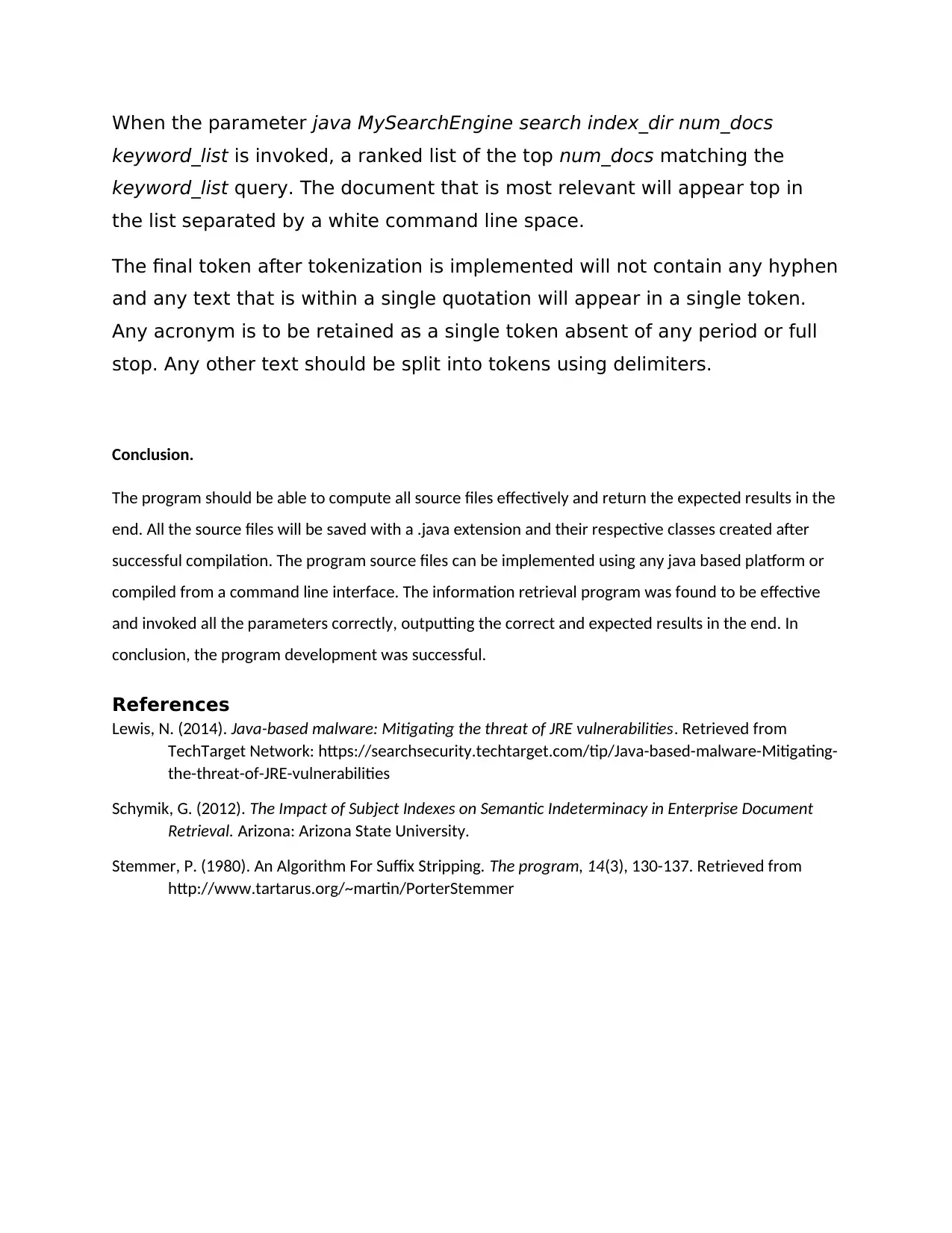
When the parameter java MySearchEngine search index_dir num_docs
keyword_list is invoked, a ranked list of the top num_docs matching the
keyword_list query. The document that is most relevant will appear top in
the list separated by a white command line space.
The final token after tokenization is implemented will not contain any hyphen
and any text that is within a single quotation will appear in a single token.
Any acronym is to be retained as a single token absent of any period or full
stop. Any other text should be split into tokens using delimiters.
Conclusion.
The program should be able to compute all source files effectively and return the expected results in the
end. All the source files will be saved with a .java extension and their respective classes created after
successful compilation. The program source files can be implemented using any java based platform or
compiled from a command line interface. The information retrieval program was found to be effective
and invoked all the parameters correctly, outputting the correct and expected results in the end. In
conclusion, the program development was successful.
References
Lewis, N. (2014). Java-based malware: Mitigating the threat of JRE vulnerabilities. Retrieved from
TechTarget Network: https://searchsecurity.techtarget.com/tip/Java-based-malware-Mitigating-
the-threat-of-JRE-vulnerabilities
Schymik, G. (2012). The Impact of Subject Indexes on Semantic Indeterminacy in Enterprise Document
Retrieval. Arizona: Arizona State University.
Stemmer, P. (1980). An Algorithm For Suffix Stripping. The program, 14(3), 130-137. Retrieved from
http://www.tartarus.org/~martin/PorterStemmer
keyword_list is invoked, a ranked list of the top num_docs matching the
keyword_list query. The document that is most relevant will appear top in
the list separated by a white command line space.
The final token after tokenization is implemented will not contain any hyphen
and any text that is within a single quotation will appear in a single token.
Any acronym is to be retained as a single token absent of any period or full
stop. Any other text should be split into tokens using delimiters.
Conclusion.
The program should be able to compute all source files effectively and return the expected results in the
end. All the source files will be saved with a .java extension and their respective classes created after
successful compilation. The program source files can be implemented using any java based platform or
compiled from a command line interface. The information retrieval program was found to be effective
and invoked all the parameters correctly, outputting the correct and expected results in the end. In
conclusion, the program development was successful.
References
Lewis, N. (2014). Java-based malware: Mitigating the threat of JRE vulnerabilities. Retrieved from
TechTarget Network: https://searchsecurity.techtarget.com/tip/Java-based-malware-Mitigating-
the-threat-of-JRE-vulnerabilities
Schymik, G. (2012). The Impact of Subject Indexes on Semantic Indeterminacy in Enterprise Document
Retrieval. Arizona: Arizona State University.
Stemmer, P. (1980). An Algorithm For Suffix Stripping. The program, 14(3), 130-137. Retrieved from
http://www.tartarus.org/~martin/PorterStemmer
1 out of 5
Related Documents
Your All-in-One AI-Powered Toolkit for Academic Success.
+13062052269
info@desklib.com
Available 24*7 on WhatsApp / Email
![[object Object]](/_next/static/media/star-bottom.7253800d.svg)
Unlock your academic potential
Copyright © 2020–2025 A2Z Services. All Rights Reserved. Developed and managed by ZUCOL.





